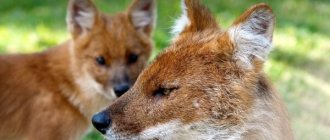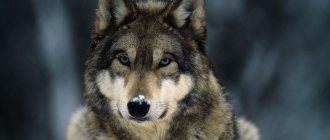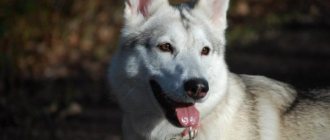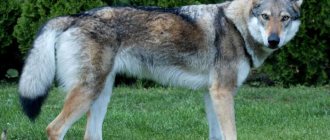- Wild animals
- >>
- Mammals
Many people associate jackal This animal represents cowardice, deceit, and sycophancy among different nations. One has only to remember the jackal named Tabaqui from Kipling’s well-known work, it immediately becomes clear that the image of this animal is not at all positive. But not everyone has a negative attitude towards jackals; the ancient Egyptians treated the beast very respectfully, depicting the god Anubis with a jackal’s head. It will be interesting to figure out what kind of predator this predator really is?
Origin of the species and description
Photo: Jackal
The jackal is a predatory mammal, a representative of the canine family, it belongs to the genus of wolves. When you look at this slightly awkward animal, you get the impression that it is something between a wolf and an ordinary yard dog. To describe a jackal, you need to pay attention to the varieties of this animal, each of which has its own distinctive features and characteristics:
- The appearance of the common jackal resembles a slightly reduced wolf. The length of its body, not counting the tail, reaches 80 cm, and its height – up to 50. The weight of an adult individual on average reaches 8 – 10 kg. The predominant tone of the coat is gray, but with light red, yellowish and fawn streaks. The back and sides are darker, may be black, and the belly and inside of the neck are usually light gray or yellowish.
- The striped jackal got its name due to the presence of light stripes on its sides. The predator's back is brownish-gray, and its tail is dark with a white tip. The jackal's muzzle is slightly shortened and wide compared to other species. This jackal has the strongest and largest fangs. There are special glands on the face and anal area that secrete a fragrant secretion;
- The black-backed jackal is very similar to the striped jackal and has red-gray fur. On the back the fur is of a darker shade; it forms something like a black saddle cloth, descending closer to the base of the tail. The weight of these animals is slightly greater than that of ordinary jackals (about 13 kg), although the body dimensions are approximately the same.
- The Ethiopian jackal is quite large when compared with other species. The mass of a male individual is about 16 kg, and the height of the animal is 60 cm. The predator has long legs and an elongated muzzle. The fur coat has a red, slightly brownish tint, which matches the light chest, inside of the legs and neck.
Not long ago, scientists conducted research in the field of genetics, as a result of which it was found that the Ethiopian jackal descended from an ordinary wolf. And their closest relatives, the striped and black-backed jackals, separated from wild dogs living in Africa and Eurasia, and wolves about seven million years ago.
Appearance and features
Photo: Jackal animal
Naturally, all types of jackals have common, unique features that distinguish them from other animals. The head of predators is not very large (the skull is about 19 cm long), has the shape of a triangle and a sharp muzzle. Jackals' ears always stand up, they can be seen from afar, they are quite large with slightly blunt tips. Eye color ranges from light to dark brown. The fangs of predators are impressive, sharp, but thin; they cut the skin of the caught victim like knives.
Video: Jackal
Outwardly, the jackal is similar to a coyote, a wolf, and an ordinary dog. He looks a little awkward, resembling a shabby, emaciated wolf or a homeless stray dog. The jackal's legs are thin and long, and its body is strong, covered with short, bristly fur. The massive fluffy tail is always pointed downwards. The coloring of different species is also varied, it depends on the area where the jackal has permanent residence.
The following tones predominate in the color of the fur coat:
- Light grey;
- Reddish;
- Brownish-red;
- Yellowish-gray;
- Dark grey.
Jackals moult a couple of times a year – in autumn and spring. Its duration is about two weeks. It has been noticed that in the summer the fur of animals is stiffer and shorter, and its color appears more red. On the abdomen, chest, chin and inner parts of the limbs, the fur is always light in color with some yellowish tints.
Another feature of jackals is the different number of toes on their paws. There are five of them on the forelimbs, and four on the hind limbs. Each finger has a short claw. It is worth noting that the females in the jackal family are slightly smaller than the male representatives of the genus.
Where does the jackal live?
Photo: Jackal dog
Jackals are quite widespread across many territories and continents; they inhabit:
- Southeastern Europe;
- South Asia;
- Near East;
- Africa.
These animals managed to take root both in steppes and semi-deserts, in forests with high humidity, in mountainous areas; animals can also be found near human settlements. Sometimes jackals migrate, looking for new places for food, thereby choosing new regions for permanent habitat. Recently, their distribution area has been moving further north. And where jackals were not found before, now they have taken root quite successfully.
As for our country, jackals used to be found in the forests of the Black Sea and Caspian coasts and were considered quite rare animals. Zoologists noticed that in the twenty-first century their number increased greatly in the Krasnodar Territory, then jackals were spotted on the Crimean Peninsula.
In 2002, they appeared in the Rostov region, and they settled there so successfully that by 2015 there were a lot of them. They chose the Don delta, settling in dense reeds. The local government even had to offer a reward for shooting these predators in order to at least slightly reduce their increased numbers.
Jackals give their preference to places with impassable thickets of trees, tall grasses, reeds, and bushes. They make dens right in the thick of the bushes. Only in semi-desert open areas do they dig small burrows. Those individuals that live in mountain ranges try not to rise above one kilometer. The proximity of a body of water is a tangible plus for the jackal, but this condition is not mandatory.
An interesting fact is that jackals are not at all afraid of severe frosts; they normally tolerate temperatures of 35 degrees below zero, but moving through snowdrifts is a real problem for them. Animals try to move along paths that were laid either by people or large animals.
It is worth noting that all four species of jackals live on the African continent, spreading throughout almost the entire continent.
Communication
Territories are indirectly maintained by scent markings and vocalizations. Both members of the couple use the leg-raised urination position to mark tufts of grass, bushes and trees. The presence of the scent of both members of a pair can tell potential intruders that they are both actively residing on their territory.
Photo: Loic Poidevin
Vocalization in the form of howls is usually used to find conspecifics, indicate personal territory and demonstrate dominance. Jackals also produce "rumbling growls" and "predator barks" when potential predators, such as spotted hyenas, approach a den with cubs. The pups respond to these vocalizations by running into the den.
What does a jackal eat?
Photo: Wild jackal
The jackal menu is very varied. These predators are tireless hunters and food seekers. Animals hunt alone, sometimes uniting in pairs to drive and kill larger prey. Jackals can make high, lightning-fast jumps, thereby grabbing birds that are already taking off. Their prey can be pheasants, trouts, waterfowl, coots, and sparrows. Jackals can also commit robbery, committing predatory raids on farmsteads, where they steal turkeys, chickens, ducks, geese, lambs, and kids.
Jackals eat muskrats, nutrias, badgers, hares, and all kinds of rodents. These omnivorous predators will not refuse a variety of insects, lizards, frogs, snails and even snakes. If you are lucky, they can also feast on fish, including suloy. A plant menu is also not alien to jackals; they happily eat various fruits, vegetables, cereals, melons, feast on nuts and berries, and will not refuse rhizomes and tubers of plants. With the help of juicy melons and watermelons they quench their thirst. In extreme heat, animals move closer to the water. If the river dries up, the animals dig holes at its bottom to drink from groundwater.
Jackals are considered scavengers, but this is not entirely true. Of course, carrion and various human waste are in their diet, but much here depends on the type of animal. For example, carrion is practically absent from the menu of the striped jackal; the animal prefers freshly caught food (insects, rodents, hare meat) and various fruits. But the common jackal does not disdain carrion; it rummages through landfills in search of food; it is often accompanied by vultures to enjoy a joint meal.
The Ethiopian jackal's menu consists of 95 percent of various rodents; sometimes it manages to feast on a hare or a small antelope. Incursions by jackals into livestock pastures are extremely rare today. So, we can say with confidence that the jackal is an almost omnivorous animal.
Eating habits
Jackals can best be described as opportunistic omnivores . Mammals make up about one third of their diet. They also eat hares, lizards, snakes, insects and beetles. Depending on location, carrion can make up a significant portion of their prey, along with fruits, berries, ground birds, small animals and invertebrates.
When hunting rodents, the jackal relies on its hearing to pinpoint the location of prey in the grass, and then quickly pounces on it or digs it out of a hole. Predators also target young, old and infirm ungulates, which sometimes weigh 4-5 times their own body weight. While jumping, jackals can deftly grab flying birds.
Photo: Ann & Steve Toon
The jackal is predominantly a solitary hunter. This is likely because food resources in most areas are widely dispersed and rarely concentrated enough for predators to feed in groups. The exception is mating pairs, which hunt together and regularly kill gazelles and fawns. Hunting together allows them to take much larger prey in areas where they are available.
In peri-urban and rural areas, jackals kill poultry, as well as young and weak sheep and goats, and move into human habitation at night to feed on edible scraps. In Africa, they often feed on the remains of spotted hyenas, lions and leopards.
Features of character and lifestyle
Photo: Jackal animal
The jackal can be called a twilight predator; it leaves its lair when it gets dark to go hunting. Although the Ethiopian jackal, on the contrary, prefers to hunt in the daytime. In search of food, jackals can travel long distances, constantly on the move. These animals miraculously sense the death of any animals and rush to taste the carrion. Interestingly, before a hunting expedition, the animal emits a long howl, like a battle cry, which is picked up by all its relatives nearby.
Jackals live in married couples, having their own territory, which they constantly mark. The size of the plot can reach up to 600 hectares. Everyone who does not belong to the family is expelled from the site. Young animals can also live with their parents, helping in raising the babies, but gradually older jackals form their own family unions and go off to look for their own territories.
Zoologists know little about the character and habits of the jackal, because... the animal is very secretive and poorly studied. Jackals are distrustful of people, although it has been observed that during severe winters they move closer to human settlements.
An interesting fact is that the black-backed jackal species is more willing to make contact with people, gets used to communication and even becomes almost tamed animals and begins to trust people. The average lifespan of jackals living in the wild does not exceed 12 years, although some specimens live up to 14.
In general, in people's minds the image of a jackal is usually negative. One of the bad traits that is attributed to the jackal is cowardice. In fact, this is unfounded. The jackal is most likely not cowardly, but very cautious. In those areas where a person is friendly towards him, a jackal can even allow him near his offspring.
Unbridled curiosity and arrogance often overcome jackals. People who stayed overnight in places where jackals live saw for themselves how they steal both food and clothing items right from under their noses. These are the jackals, unique animals with many interesting character traits.
Social structure and reproduction
Photo: Jackal
All species of jackal, except the Ethiopian, are considered monogamous. Animals form a family unit for life. Both parents are very caring and sensitive; together they arrange their home and raise their offspring. Jackals either dig holes themselves or occupy the abandoned dens of foxes, badgers, aardvarks, and porcupines. Animals can use old termite mounds, large hollows, crevices, and dense thickets for housing. If jackals live in a hole, then there must be a wide nesting chamber located at a depth of about one and a half meters.
It is interesting that a young female, ready to mate for the first time, accepts the advances of several gentlemen, who sort things out among themselves through violent fights; their winner becomes her companion for life. Depending on the permanent place of registration, the mating season of the common jackal can begin either at the end of January or in February, its duration is about 28 days. At this time, you can hear the strong howling of these predators.
There is no specific time of day for mating; it can occur at any time. Sometimes a female does not get pregnant right away, so a few days after the first heat, the second begins. If pregnancy does not occur the second time, then you will have to wait until next year. The duration of the gestation period lasts on average from 57 to 70 days.
In a litter, a jackal usually has from two to four cubs, sometimes there are eight of them. Babies are born with soft fluffy fur, completely blind and weigh about 200 grams. Gradually, the color of their fur changes, redness and bristly hairs appear, and the puppies begin to see the light closer to two weeks. By this time, they also develop hearing, and by the age of one month, babies take their first steps, standing on stronger legs.
A caring mother treats her offspring with milk until approximately 2 to 3 months of age. By the age of twenty days, common jackals begin to feed their babies with regurgitated food and meat. Teething in babies begins as early as two weeks of age and lasts until almost five months. Puppies quickly gain weight; by the time they are a month old they already weigh half a kilogram, and by four months they weigh more than three.
Females become sexually mature closer to the age of one year, and males a little later. Despite this, young jackals often continue to live with their parents until they are two years old.
Common jackal, or Asian jackal, or common jackal, or African wolf
Common jackal, or Asian jackal, or common jackal, or African wolf (Canis aureus)
Class - mammals Order - carnivores Family - canids
Genus - wolves
Appearance
The jackal is a small animal, smaller than the average mongrel. In general appearance it is very similar to a greatly reduced wolf. The body length of an ordinary jackal without a tail reaches 80 cm, and the height at the shoulders does not exceed 50 cm, usually 42-45. It weighs 7-10 kg, rarely more. The jackal is slimmer and lighter than the wolf, its legs are relatively higher, and its muzzle is sharper, although more blunt than that of the fox. The tail is shaggy and appears very thick; it is always lowered down, like a wolf's. The hair on the body is short, hard and thick. The front paws have 5 toes, the hind paws have 4, and the claws are blunt.
The general color of the jackal is generally gray with a tinge of yellow, red, and fawn. On the back and sides the color turns black, and on the belly and throat it turns light yellow. The end of the tail is black. The color of the jackal, however, is quite variable depending on the region of its habitat. Summer fur is generally shorter and somewhat coarser than winter fur and has a more reddish color, with less black admixture.
Habitat
Distributed throughout India and regions to the west of it - in the Near and Middle East, Central and Asia Minor. The jackal lives throughout Africa north of the Sahara. In Europe, it is found in Greece and the Balkans, the Caucasus, Dagestan and almost the entire Black Sea region, although in this region the range is highly fragmented.
Throughout the entire length of its range, the jackal prefers places heavily overgrown with bushes and reed beds near water bodies. In the mountains it rises to a height of up to 1000 m, but in general it is less common in the foothills.
In nature
The common jackal is an almost omnivorous animal. It feeds mainly in the dark. Carrion is of great importance in nutrition, but not predominant, as in hyenas. Catches a wide variety of small animals and birds, as well as lizards, snakes, frogs, snails; eats a lot of insects - beetles, grasshoppers, various larvae. Jackals love to wander near water bodies where they find dead fish. In severe winters, when the water in reservoirs freezes, the jackal hunts mainly wintering waterfowl. Having found the carcass of a fallen large animal, jackals often gather in groups and eat carrion in the company of flocking vultures.
Jackals often hunt alone or in pairs, and occasionally in small groups. They deftly sneak up on the victim and instantly grab it. When hunting together, they chase prey against each other. The jackal is a highly developed animal; it is not only smart and cunning, but also very dexterous and agile. In a high jump, he can grab a bird that has already risen into the air. Birds that nest on the ground - pheasants and roaches - suffer greatly from jackals. The jackal conducts its hunting search at a small trot, often stopping to sniff and listen. Where there are large predators, jackals follow them to take advantage of the remains of their prey, snatching scraps right from under their noses. Jackals are sedentary animals and do not make seasonal migrations, but sometimes they go far from their permanent place of residence in search of food and appear in areas where there has been a massive death of livestock or wild ungulates to feed on carrion.
The jackal eats many fruits and berries, including grapes, watermelons, melons, plant bulbs, and wild sugar cane roots. In Tajikistan, in autumn and winter it feeds mainly on oleaster fruits.
Jackals living near humans feed largely on garbage. In the villages and cities of South Asia, they rummage through garbage dumps and garbage heaps, snooping around in search of edible morsels among the huts of poor areas.
The jackal is a cunning and impudent animal. In terms of the level of audacity of attacks on poultry houses and peasant barns, it perhaps surpasses even foxes. However, the jackal is too cowardly to be the first to attack a person, and therefore the suffering that people receive from these animals is too small.
The jackal is very loud and vociferous. Before going out to hunt, the animal emits a loud howl, similar to a high, whining cry, which is immediately picked up by all other individuals nearby. They begin to howl for other reasons, for example, when bells ring, sirens sound, etc. In addition, jackals scream all the time while running. In cloudy and pre-storm weather they are more silent, but howl a lot on clear nights.
Reproduction
Jackals form pairs for life, and the male takes an active part in constructing the burrow and raising the brood. Jackals are in heat from the end of January to February, sometimes until March. The rut is similar to that described for a wolf - jackals howl loudly. Pregnancy lasts 60-63 days. Puppies are born from the end of March to the end of May. There are usually 4-6 of them, occasionally up to 8. The female usually gives birth in a burrow, which is a simple passage up to two meters long and up to one meter deep. Jackal burrows are thus constructed much simpler than fox burrows. There is usually a large pile of earth piled in front of the entrance hole. The jackal hides in these holes during the day, and at other times in times of danger. Occasionally, several burrows belonging to different individuals are located in close proximity. Burrows are made in the most impassable places.
The female feeds the cubs with milk for 2-3 months, but already at 2-3 weeks of age she begins to feed them, regurgitating the swallowed prey. In autumn, the young become independent and hunt alone or in groups of 2-4 animals. Females reach sexual maturity in about a year, and males in two.
Life expectancy is up to 12-14 years.
Captivity
Jackals raised in captivity are easily tamed and resemble a dog in their behavior - they cuddle up to their owner and wag their tails in a friendly manner. Also, jackals easily interbreed with dogs, sometimes even without human intervention.
Since jackals live in different climatic zones, they are perfectly adapted to endure both severe frost and extreme heat. Thanks to this, they can be kept outdoors throughout the year. This sets them apart from other exotic dogs. In addition, the jackal can be kept freely, like a dog. In captivity, jackals are active only during daylight hours.
As for enclosure keeping, in different zoos, depending on specific conditions and capabilities, they use a variety of ways to keep jackals. In general, the premises for keeping them can be divided into two groups: large enclosures not covered with a mesh on top, usually with a natural enclosure substrate, or relatively small cages and enclosures with a mesh roof. Earthen burrows dug under hills or made under a pile of tree trunks are used as shelters. Sometimes they use houses made of pressed plastic, installed on a cement base, into which hay is placed in winter. Each house has a veranda for shade; for the same purpose, there are various canopies in the enclosures. Enclosures should be shaded by small trees and bushes. You can also use wooden houses as shelters. The soil should be earthen; in each of the enclosures you need to put a large sandbox in which the jackals willingly wallow and dig. The minimum size of an enclosure for jackals is about 10 m2. Under these conditions, the couple reproduces successfully, however, such conditions must be considered extremely cramped and in need of improvement. Under such conditions, cubs have to be separated from their parents very early. All equipment of the enclosure consists of two low shelves and a large house, the slanting roof of which the animals also use to view the surrounding space.
Don't forget that jackals are not used to idleness. You will have to come up with special entertainment for them, and participate in some of them yourself. Hang a piece of hose, a wheel, put down sticks, and so on. From boredom, animals become lethargic and quickly gain weight.
The daily meat requirement for one adult jackal is 0.4 kg. It may vary depending on the season, gender, and age of the animal. In winter, the amount of meat provided is increased to 0.6 kg.
Meat is replaced once a week in the same quantity with live food: guinea pigs, rabbits, chickens. Skin, feathers and bones are also necessary for digestion. Without them, his stool will be thinner than usual.
Be sure to include eggs, cottage cheese, milk and plant foods in your diet: carrots, bran, greens, oatmeal, rolled oats and other cereals in the form of porridge. Don't forget about vitamins.
Life expectancy in captivity is up to 16 years.
Natural enemies of jackals
Photo: Common jackal
Jackals have a lot of enemies in the wild, because they are not a very large predator. Wolves and ordinary dogs are hostile to jackals, although the latter often coexist peacefully with them, rummaging side by side in the same landfills. Previously, when there were much more large predators such as leopards and tigers, they also caused significant damage to the jackals, although they also had benefits, because the jackals ate the remains of their meal. Now in natural conditions, competition for jackals includes foxes, hyenas, jungle cats, raccoons, and wild steppe cats.
People can also be considered enemies of jackals, because in some areas they exterminate animals, considering them pests for their cultivated plots and farmsteads. In addition, black-backed jackals are hunted for their beautiful and valuable fur, which is used to make carpets in the south of the African continent.
In addition to various predators and humans, one of the most dangerous enemies of jackals are various epidemics and diseases that claim the lives of many animals. Since the diet of many predators often includes carrion and waste, they act as carriers of rabies, transmitting the disease to many animals. In Africa, 25 percent of animals become infected with rabies from jackals.
In addition to rabies, jackals can carry distemper; they are often infected with all kinds of ticks, helminths and other parasites. Sometimes animals die due to lack of food, especially in the harsh winter. So, there are plenty of enemies and various unfavorable conditions that threaten the life of jackals in the wild.
Save Status
The International Union for Conservation of Nature has recognized jackals as a "species of least concern" . They are quite common throughout their range, with at least 80,000 individuals on the Indian continent and an unknown number in Africa. But in the European Union the species is protected at the legislative level.
However, increasing habitat loss due to population growth and associated expansion of roads, settlements and agriculture threatens the jackal. Livestock rearing and farming, which support the survival of jackals and other wild animals, are now being replaced by industrialization and unsustainable agricultural practices.
Human-wildlife conflict is a growing threat. As habitats are lost, jackals increasingly invade human settlements , where they may be seen as a danger to livestock and poultry and die as pests. They are also often persecuted as carriers of rabies.
Population and species status
Photo: Wild jackal
The distribution range of jackals is quite wide, it covers more than one continent. Due to the fact that these predators are very hardy and can adapt to different conditions, they began to spread to areas where they had not been observed before. Perhaps these migrations are associated with the search for new sources of food.
The common jackal is not in danger of extinction. In many areas its numbers are only increasing, and the habitat of this jackal species is expanding. And where the predator was considered a great rarity, it successfully bred and feels excellent. For example, here we can name Serbia, Albania and Bulgaria. Jackal hunting has been strictly prohibited in these countries since 1962, because... the animal was practically never seen, now the situation has changed and the jackal population is not in danger, which is good news.











